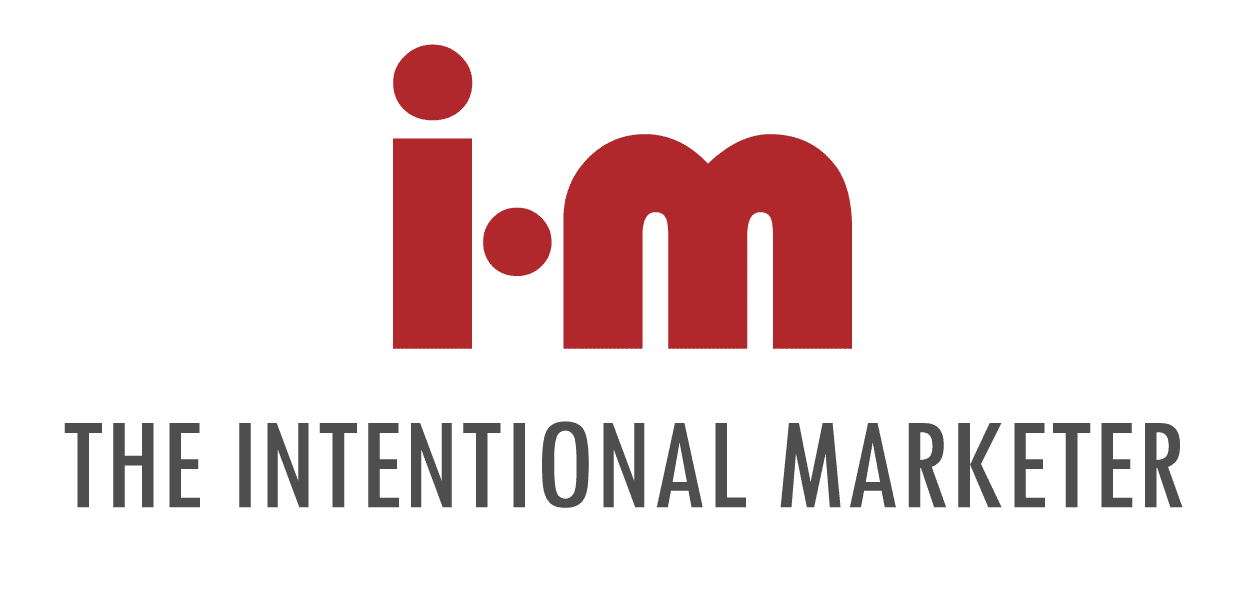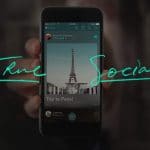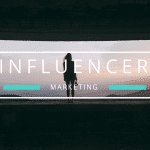Welcome to the interview series: “The Marketing Pulse”. I highlight a business that has excelled in marketing, the Intentional Marketing way. Thinking differently, being intentional, and being purposeful.
I chat with companies of all sizes from smaller brands that need to be very intentional and creative to compete and win in their space, to larger brands who are a lot more visible and need to be intentional to continue to retain their market share.
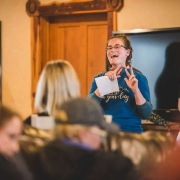 MEET LIZ WILCOX
MEET LIZ WILCOX
Job Title: Founder, Author
Business name: The Virtual Campground (TVC)
Business started: Dec 2016
Purpose of your business: Provides humor and services to keep full-time travelers on the road.
Target audience: Full-time RVers, age 20-55, who still need to work and crave community while traveling.
Core Value/s: We believe every RVer should have fun despite adversity in the lifestyle. We value community and overcoming obstacles, but above all, laughter.
S: Hi Liz! Thank you so much for sharing your intentional marketing story with us! Congratulations on building a successful brand in the RVing space! How did you determine who you were going to target? There are hundreds of thousands of RVers and most people would think of RVers as older folks who are enjoying their retirement.
L: RVing is a passion of mine. And I knew I couldn’t have been the only one out there who was obsessed.
I’ve had lots of personal conversations with a general audience of RVers. I’ve done these through email, phone calls, video chats, and even in-person meetups. From an online business owner perspective, I’ve also conducted a/b testing of business pillars, blog posts, email campaigns, etc.
S: So talking to a general audience, and then narrowing down to your niche target by determining who responded better to your story and business model?
L: Yes, exactly!
The first six months of my business was simply taking that free general audience on social media and interacting.
Much to my husband’s chagrin, I lived on Facebook.
I unfollowed every friend that wasn’t an RVer and removed myself from all groups except…you guessed it! RV groups. Everything I saw on social media was related to my niche.
I was absolutely immersed in the culture.
I’d spend hours in groups reading over threads and collecting data. I began to see trends and get a real feel for the RV community. I saw how I could grow my business for certain groups but not for others. That said, I also discovered my business’s core values aligned with much of the RV community. Talk about a HUGE bonus for me, right?!
S: Can you explain a little more about your process for a/b testing business pillars?
L: When I first launched my online business, I had courses on downsizing, finance, and the transition to RV life. These seemed to be my target audience’s main pain points, and right out of the gate I wanted them to know The Virtual Campground was their answer!
I found these courses absolutely laborious to create. Turns out my audience could tell! They weren’t very popular and people were leaving them left and right.
Once I started opening up a little more and sharing my story, I started connecting with potential customers. In fact, these people helped me create my first product.
I conducted a survey with my email list and Facebook following. I asked them what they liked about The Virtual Campground. They said the humor and storytelling. That’s when I came up with the idea to sell a book about funny RVing stories.
I had the product ready about 6 weeks later.
After the success of Tales From the Black Tank, it was easy to see I needed to pivot my business. I now only target people who like humor and storytelling within the RV niche.
S: What marketing channels do you use to market your business?
L: As an online business, I mainly use my blog to market my business. It’s like a billboard for my products and services. I don’t have ads on my site. Instead, I use the sidebar to advertise my own products. It’s prime real estate! I make passive income almost every day from my sidebar with my own products!
Going along with that model, I’ve found great success in guest posting. Writing for other larger websites in my niche has really helped broaden my reach.

For example, when I launched my first book, I went on a “virtual tour” of related websites. I marketed it like a concert with images that looked like concert posters and dates of when the posts would go live. I did 6 “locations” in a week’s time. It made me look wildly popular, as I was in a different “place” every single day.
Each post I wrote was specifically written for the individual site’s target audience, but I made it related to my book. For example, one post I wrote was about the worst complaints about RVing with kids, and I tied it to other humorous stories one would find in my book. The post was written for a website that is popular among RVing families.
After the initial launch of my book, I partnered with an international company to buy a mass amount of my ebook. They then used the book for lead generation. I highly suggest this method if you can find a company you’d love to work with and aligns with your values. It’s not only a way to make money, but it’s an incredible opportunity to broaden your audience quickly.
I’ve also partnered with other small business owners within my niche to host online and in-person summits and workshops. This is a great way to provide a ton of value, upsell, and gain amazing, loyal customers.
One of my favorite ways to market is via Facebook live events. I find the instant interaction with the audience not only fun, but important to my marketing strategy! I can adjust the webinar immediately as potential customers converse in the comments. I see marketing not as something I need to do in order to sell, but something I need to do in order to serve.
I’ve also used Instagram stories and hashtagging to market!
S: You’re really using some creative marketing techniques. Hashtagging is pretty awesome. I think most people will know what a hashtag is, but can you explain this as a marketing tactic?
L: Sure!
As I’ve said, social media is a huge part of marketing for me. And hashtagging is essential to my social media strategy.
In short, hashtags organize information on social media. They started on Twitter and have since taken over almost every platform. You put a hashtag on it, and it’s automatically put in a category. If someone searches that category/hashtag, they may stumble upon your post and engage.
This is huge for a marketer looking to expand and amplify a brand. It helps your target audience find you!
There are 3 main ways to use hashtags.
- Brand/campaign specific.
These are hashtags you makeup and are specific to your business. This helps people recognize your brand as something unique.
For example, I do something on Instagram called Today’s Neighbor, where I post a picture of an RV with a short description. I end it with #todaysneighbor. After only a month of using this hashtag strategy, I had people tagging me and using the hashtag in RV pictures they found interesting. A year and a half later, it’s not uncommon for me to get DMs and emails regularly from people showing off their “neighbor.”
It even landed me a gig at an RV-specific business conference where I led RV tours. Hashtagging is crazy powerful.
- Trending
These are hashtags to use that are really popular in your niche. The customers you’re looking for are using and looking at these hashtags, so it’s smart to use them too.
In my niche, things like #rvlife and #vanlife are always trending. On Instagram, I try to use about 20 trending hashtags for each post. I switch them up every few days because as you know, trends are constantly changing.
- Content
People search for these hashtags when interested in purchasing. Use a few of these when promoting a sale to boost your visibility. When I was launching my ebook, I used hashtags like #funnybook and #rvguide.
S: It sounds like you’re marketing your brand on a limited budget, and leveraging ‘free’ tactics to promote your business (although I’d argue that there is a cost to these marketing techniques = your time!). How did you determine which tactics to use?
L: You’re so right! I spend a lot more time on marketing than money!
As a new entrepreneur, every single aspect of my business was overwhelming. Every article I read told me to focus on this, to do that. Trying to do everything at once was burning me out quickly, but I knew I didn’t have money to invest initially on VAs or strategists, etc.
I decided to stop thinking and researching so much. I asked myself what was easiest for me right then and there. And then I did that. Just that.
And I’ve found so much success in truly mastering one thing at a time.
Starting with Facebook, I learned about groups. Then pages. I know about the algorithms and how to “help them along.” I dove deeper and practiced Facebook Lives, resulting in an online summit with over 1000 attendees! I was able to do that because I wasn’t worried about any other strategy.
Once I felt more than confident with Facebook, I moved onto email leads and marketing. I read books, asked friends, and then tested. And then tested again. I spent 10-15 hours a week just emailing people. There was no time for anything else!
And so on I went down the line of marketing strategies.
So instead of my knowledge base being very shallow and wide, it’s narrow but very deep. And I’m okay with that.
S: What makes you different from your competitors?
L: No one else in my industry uses humor to reach its audience like me. The Virtual Campground isn’t just a travel blog. It’s a website for travelers. The focus on community and not the individual is unprecedented. All products and services not only serve the audience of TVC but feature them.
Who else can boast that?
S: The travel blogging industry is HUGE. I agree that a lot of the travel bloggers are focusing on their own stories.
With your focus on your community’s stories, that is a big change from the traditional travel blogging business model! Making it all about your community/audience vs. yourself.
There is a lot about this model I love. Our focus at The Intentional Marketer is on being “intentional”. How is your business intentional (overall) and in relation to your marketing?
L: Standing out in a sea of bloggers can be hard. Marketing must be intentional.
Every post on TVC is directly related to my target audience for the sole purpose of getting them to subscribe. Every word is written about them and for them.
Travel bloggers make the mistake of writing journal-like posts. Because I am intentionally marketing a certain person, I don’t write those things. I write “BuzzFeed-like” articles that are click-worthy and entertain a much larger audience. This makes for great content that people want more of, so they subscribe.
Once they’ve subscribed, that’s when I give them journal-like posts. Again, this is intentional. I’ve already hooked them with something good, now I need to keep them by sharing myself.
In this modern age, people don’t buy products. They buy a story.
So I give them my story and encourage them to be involved in it through constant email contact. Intentionally, I work very hard to get all subscribers to reply back after an email. It’s my way of encouraging my subscriber to become part of my story. This makes my followers feel special (they are!) and loyal.
I also do lots of Facebook Lives. Every “Live” is intentional and serves a purpose. I never go live just to be seen. I want to serve the people watching. I entertain, teach, or inspire in every video. This is all thought out and intentional for what is coming next in the business. Same for Instagram, emails, posts, etc.
S: Coupled with the ‘un-travelblogging’ model that you’re using (yes – I just made that word up!) for TVC, you’re also making sure that every piece of content you create has a purpose and serves your audience. Love it!
In addition to all this, what else are you doing differently – uniquely- to stand out from the crowd?
L: I am standing out by being very visible, and also helping my “competition” do the same. My first 2 products were made with other people within my niche. This is very different than anyone I’ve seen. It makes me the “connector”. This serves two purposes:
- My audience shares my products because they see me as genuine and as part of the community.
- My business peers connect me with others because they see me as a “helper” and know what I am capable of. This has helped me make great connections with companies a small brand like myself normally wouldn’t have a chance with.
I am also sharing with my audience every good, bad, and ugly part of my business AS I BUILD IT. I’m not afraid to tell people I want my website to be a business and I have my audience cheering for me to succeed and be an active part of that. I am creating hilarious content that a huge audience can relate to.
Internally, my business motto is “when everyone zigs, I zag.”
S: I love that Stephen Anderson quote! What a great motto to have!
So with “zagging” in mind, can you describe your customer experience, and how you’ve made it unique or intentional?
L: Every person that has become a customer of mine, has gone on a journey. I like to think of this journey in 3 parts:
- Follower
- Friend
- Customer
First, that person is a follower. Like stated above, I wrote something they liked and they subscribed to my email list, liked my page, etc etc.As soon as they become a follower, it’s my job to make them a friend. In email, I do this through a well-thought-out email sequence where I’m engaging them to respond. When a response comes in, I can have genuine conversation and get to know them a bit. I ask them questions about themselves and their RVing journey.
Not only do I read and respond, I also start segmenting them to ensure I remember them as a person. This is so important! I don’t want to send out an email selling them a how-to RV guide if they’ve been RVing for 10 years!
Once we are friends, I can much more easily turn them into a customer. Again, I’ve gotten to know them! I know their needs and wants and can bring them something accordingly.
This model is unique and intentional, but absolutely essential in the online business world. Again, people don’t buy products, they buy stories! And how does someone get to know your story?
You befriend them, of course!
S: Do you have a brand fan – brand ambassador – campaign? What was your goal and approach?
L: I am currently planning one of these for a second book launch this summer.
Because I am creating a community of friends before customers, it’s a little easier for me to identify who is an active brand fan who I can turn into an ambassador.
I plan on asking 100 people to help promote my book with me. They will be my launch team and will spread the word of my book. I also plan on asking if they have any larger connections to get my book in the hands of manufacturers and publishers, etc. My goal is to get the book written, funded, and in stores across the nation.
S: Great idea using your community to be your book launch team!
One of the questions I always ask myself when creating messaging and content for clients is “What is in it for the customer”. If they invest time (to read a blog), brain power (to complete a task), money or anything else into your business, what are they getting in return? It doesn’t need to be tangible like a ‘freebie’. It could be a sense of honor or value. In your case, you’re asking your brand fans to promote your new book. What do you feel they are getting in return?
L: A sense of community. That’s what TVC is all about. Bringing people together through humor and storytelling. I call it The Virtual Campground because that’s what I want it to be. I want people to share stories with me the way they would if we had met at a campfire, or were neighbors at an RV park.
People want a place to belong. And I want to facilitate that. I think the people who promote my book will feel a sense of belonging and like they are helping their community be a happier place.
S: What has been your biggest achievement to date (in relation to marketing)?
L: Full-Time Freedom Week was an online summit I created to sell a bundle of products.
To start, I was off on the wrong foot. I only had one product, but that wouldn’t stop me.
I asked some close friends within my niche to create related products. They had 2 months to do so. Then, I told them to ask their friends to share products with us. I promised everyone I would take care of the marketing piece.
Within a month, I had 7 brands and products on my team.
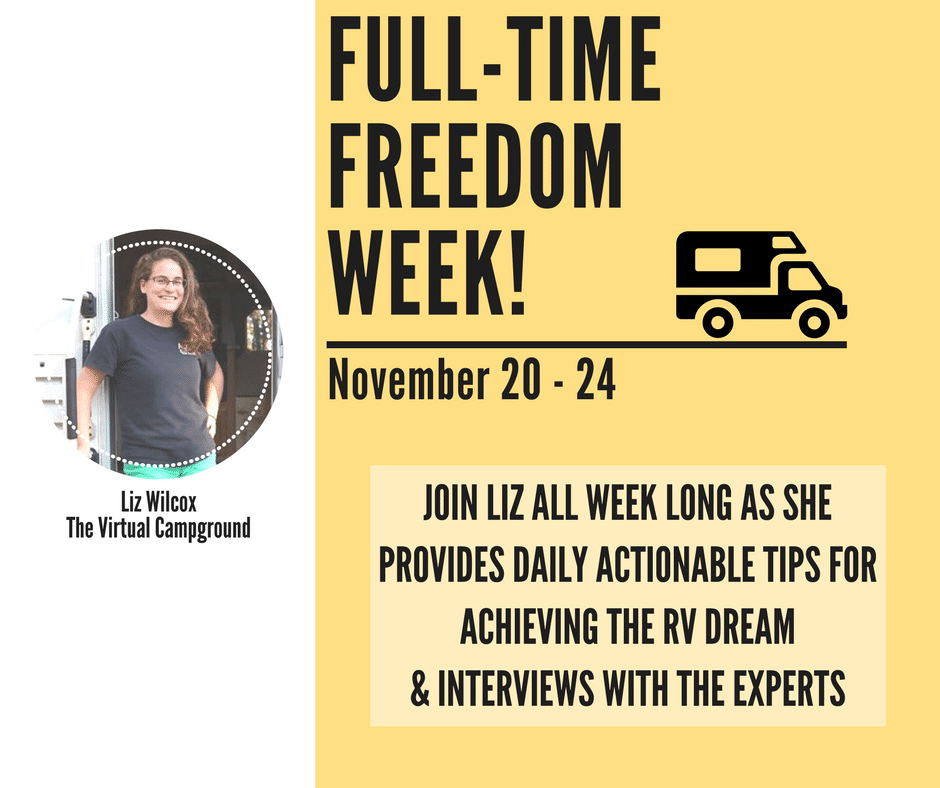 My marketing idea was to sell this bundle through a virtual summit called Full-Time Freedom Week. It was going to target new RVers and dreamers.
My marketing idea was to sell this bundle through a virtual summit called Full-Time Freedom Week. It was going to target new RVers and dreamers.
Each brand promoted it following set guidelines.
I hosted it through a Facebook event and Lives in that event. (Facebook loves and favors both of these things.) Before the event kicked off, we had almost 1000 attendees marking ‘going’ and another few hundred marked ‘interested’. By the end of the event, numbers were well over 1000.
I led the team to get over $1500 in sponsored giveaways, email market to nearly 10,000 people and sell over $4000 in 8 days.
I interviewed top names and brands in the RV industry for 5 days straight, 2 or 3 times a day. I gained many new and very loyal fans and helped my team establish themselves as authorities in the niche.
This was all before the 1 year anniversary of starting my blog, brand, and business.
S: What a huge accomplishment! You know how to hustle!
Is there anything else you can share about how you intend to approach customer experience and marketing for your business?
L: I intend to clean up my website this year for a better customer experience and will have 5 products by December 2018. All product ideas will be confirmed by my email list and audience before I start creating them. I just don’t see why anyone would do it any other way.
S: Confirming your product ideas to your email list audience is a step that a lot of businesses skip. Too often they go right to launch without knowing if there is a need for their product in the marketplace. It is probably the most important step to take!
You are fortunate to have a large email list to confirm against. But what would you suggest for businesses that have small (or even non-existent) lists?
L: The first product I created was for a list of only 300 people.
Like I said, I just simply asked these people what they liked about me, then put two and two together.
You can do this at any level of your online business. I’d also suggest throwing it out on social media. If you have an idea, you can literally just ask people with a Facebook update!
Try something like…
“I’m thinking of creating a course on xyz. Would you be interested in that?” You may be surprised at who answers and what they say!
Liz, thank you for your time! Your energy and tenacity are inspiring. You have shared some amazing insights into your business. I appreciate your candor and I wish you the best in the launch of your next book and the continued success of your business!
